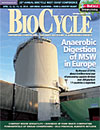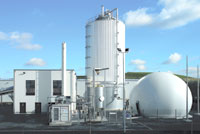 BioCycle February 2010, Vol. 51, No. 2, p. 24
BioCycle February 2010, Vol. 51, No. 2, p. 24
By the end of 2010, expected installed anaerobic digestion capacity to treat mixed municipal solid waste and source separated biowaste will be about 6 million tons/year divided over 200 plants in 17 European countries.
Luc De Baere and Bruno Mattheeuws
SINCE the introduction of anaerobic digestion (AD) of municipal solid waste and biowaste (separated organics) in the beginning of the 1990s, adoption of the technology in Europe has been increasing. In the early years, only a handful of digesters running on biowaste or MSW were installed. Now, almost 200 of these digesters will be operating in Europe by the end of 2010. An inventory of the existing, contracted plants and plants under construction was conducted to provide an overview of the state of the technology in 2010.

The following criteria were taken into account for the inventory:
At least 10 percent of organic solid waste from household origin needs to be treated in the plant, with a minimum capacity of 3,000 tons/year.
The design capacity of the plant, unless specified differently by the supplier/operator, was utilized. For biowaste, total capacity of the plant was used; for mixed and residual waste plants, the actual capacity going into the digesters was used.
Plants taken into consideration have to be at least under construction or contracted and situated in Europe. A prognosis was made for 2011 and 2012. Plants were not eliminated if operation ceased as the number is minimal.
DIGESTION CAPACITY
The pace of growth in the first decade of the 21st century has been remarkable. More than 70 plants treating biowaste or MSW were installed during the last five years (2006-2010) in Europe. The expected installed capacity by the end of 2010 will be about 6 million tons/year (tpy) divided over 200 plants in 17 European countries. (In contrast, 15 plants were installed between 1991 and 1995, with total capacity of about 200,000 tons.)
As shown in Table 1, the increase in new facilities was very high during the 1996-2000 period (8.8 plants/year), levelled off slightly in the following five years (10.4 plants/year), then grew again from 2006-2010 (14.6 plants/year). The average size per plant also increased – from 13,000 tpy in the period 1991-1995 up to 40,000 tpy in the 2001-2005 period. During the last five-year period, the average plant size dropped to about 30,000 tpy. Figure 1 illustrates the evolution of installed AD capacity, starting in 1990.
The variation in the average size of facilities can be explained by the fact that smaller plants were built in the 1990s as the technology was not fully matured and AD plants were mainly constructed for digestion of biowaste (source separated organics). Subsequently, more and more mixed waste AD plants were constructed in the first five years of 2000. Mixed waste plants usually handle 100,000 to 200,000 tpy, of which 30 to 70 percent is treated via digestion.
From 2005 onwards, more biowaste plants were built again, and the successful introduction of partial stream digestion occurred, reducing the average size of the plants constructed. Partial stream digestion is where only a part of the substrates on a site are sent to AD. The remaining portion bypasses the digester plant and is mixed with the digested residue to go to composting. For example, partial stream digestion is being used at existing composting sites that want to extend their capacity by adding AD on the front end of their facility. The wetter substrates go to digestion and the drier substrates go directly to composting. As a result, the capacity of some partial stream AD plants is smaller.
However, a lot of large-scale AD facilities are planned in countries like the United Kingdom and France. Generally, source separation of household waste is less actively encouraged in these countries, resulting in large MSW-based AD plants. Switzerland, Austria, Sweden and Norway tend to install smaller anaerobic digestion units (8,000 to 15,000 tpy), while countries like Germany, Belgium and Italy install plants with a medium average size (30,000 to 50,000 tpy).
Germany is the leader in anaerobic digestion capacity in absolute figures: More than 1.7 million tons of installed capacity is expected by the end of 2010. This represents 75 plants with an average installed capacity of 23,000 tpy. Spain is second (1.5 million tpy), followed by France (800,000 tpy). However, on a per person basis, Germany and France are only sixth (Germany) and eighth (France) among European countries. Leaders seem to be Malta and Luxemburg (small countries with only one or two plants and very few inhabitants), followed by Spain (with a capacity of 34,000 tons/million inhabitants), Switzerland (33,000 tons/million inhabitants) and the Netherlands (29,000 tons/million inhabitants).

ANALYSIS OF INSTALLED CAPACITY
Although the biochemical process is quite similar in all anaerobic digesters, there are a number of system providers in the marketplace and even more digestion concepts and process configurations. Generally speaking, the primary distinctions in terms of process parameters are temperature (mesophilic versus thermophilic), moisture content inside the reactor (wet versus dry), complexity (one phase versus two phase), single feedstock digestion versus codigestion and input substrates (residual/mixed waste versus biowaste).
Mesophilic vs. Thermophilic Digestion: Industrial anaerobic digesters in Europe can operate at two different temperature ranges; mesophilic (35°C-40°C; 90°- 100°F) or thermophilic (50°C- 55°C; 120°- 130° F). Table 2 shows the evolution of mesophilic vs. thermophilic AD plant installations between 1990 and 2010. At the start, almost all facilities were operating at mesophilic temperature, mainly because this was considered a more stable process and because of the lesser need for heating. Thermophilic digestion emerged during the 1990s and the capacity of both techniques increased during the past two decades with mesophilic digestion being predominant. During the 2000-2005 period, a number of large-scale, mostly wet, mesophilic plants were constructed but after that period, number of thermophilic plants installed increased significantly.
Wet vs. Dry Digestion: Although several definitions are possible, dry digestion can be defined as more than 15 percent dry solids inside the reactor. Wet and dry digesters both have their advantages and disadvantages; which one is utilized also has an influence on the pre and posttreatment of the substrates. As is illustrated in Figure 2, dry digestion has almost always been predominant, excluding the 2005-2006 period. During the last five years, 63 percent of the installed capacity is dry digestion and currently provides almost 60 percent of the total capacity while wet fermentation is used in about 40 percent of the total installed capacity. This steady increase in dry digestion over the past five years is due to implementation of partial stream digestion (dry systems can avoid excess wastewater production) and by the development of new batch type of dry fermentation systems. MSW and biowaste can be treated in dry or in wet digestion plants. In some cases, plants are constructed that treat biowaste and MSW on the same site.
One-Phase vs. Two-Phase Digestion: Anaerobic digestion is a common denominator for the different processes that occur simultaneously and sequentially in the biomass, resulting in the production of biogas. These different processes require different optimal conditions. Therefore some system providers developed their technology using different vessels with the aim of optimizing the process and maximizing biogas production. However, the advantage of a supposed faster degradation during the digestion step is usually not enough to compensate for the higher capital cost of the separate step. Also, high-rate dry digestion processes have been developed in a single phase. In Europe, the market share (cumulative installed capacity) for two-phase digestion has declined from 30 to 40 percent in the 1990s to less than eight percent at the end of 2010. During the last five years, only five percent of the installed capacity was two-phase digestion.
Single Feedstock vs. Codigestion: Many farm-scale digesters in Europe are codigesting manure together with energy crops or industrial (organic) waste streams. But in household waste treatment, codigestion is more the exception (only 8 percent by the end of 2010). And if facilities attract other substrates, this usually is a small proportion (e.g. some by-products of a nearby food processor or industrial facility with an organic waste stream).
Residual/Mixed Waste vs. Biowaste: In the beginning of the 1990s, there was hardly any source separation, thus most anaerobic digestion plants in that time period were treating mixed waste. When source segregation became more popular, most new AD plants were designed to treat biowaste. As a result, the installed capacity for biowaste increased very quickly at the end of the 1990s. Nevertheless, there are many regions where source separated collection is not common; when these countries (such as Spain and France) start providing incentives for AD, mainly mixed waste plants are installed. By the end of 2010, there will be almost as much installed capacity for residual/mixed waste as there is for biowaste. In fact, during the last five years, there was as much capacity installed for biowaste as there was for residual/mixed waste (± 1,120,000 tons).

TRENDS AND OPPORTUNITIES
In their search to augment production of bioenergy, many countries and existing composting facilities are considering (or already implementing) use of anaerobic digestion on the front-end of facilities or for partial stream digestion. Many biowaste composting plants were built in the early 1990s, and need significant revamping. It is expected that many aerobic composting plants are or will be replaced by AD plants. Besides energy production (and the related revenue stream), the major reasons are odor management followed by better hygienization in the two steps (AD followed by aerobic maturation). Other benefits are avoidance of water addition (to compost), increase in total treatment capacity and the flexibility and potential this combination offers in terms of biological waste treatment.
Anaerobic digestion is not the panacea for treatment of municipal solid waste but has captured a very significant share of the market of biological treatment. The technology has improved and matured, and many large-scale plants have been operating reliably for over 15 years. Higher efficiencies in the generation of electricity by gas engines as well as improved gas separation technologies are rendering the biogas more and more valuable, besides any monetary stimulus policy for bioenergy. Concerns over greenhouse gas emissions and the need for renewable energy will only make anaerobic digestion all the more attractive in the future.
Luc De Baere and Bruno Mattheeuws are with Organic Waste Systems NV in Gent, Belgium.
February 23, 2010 | General










